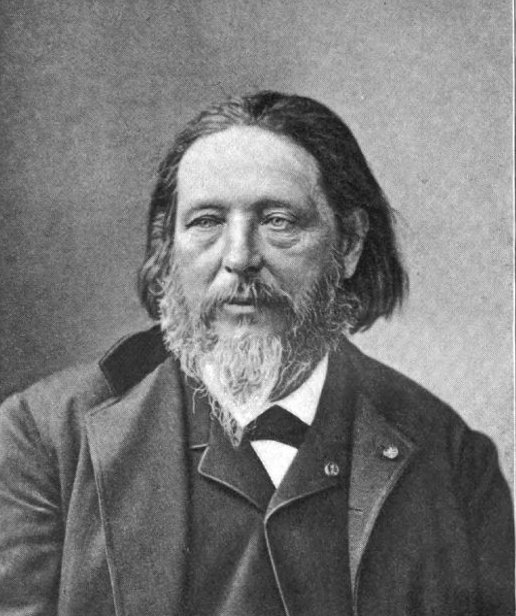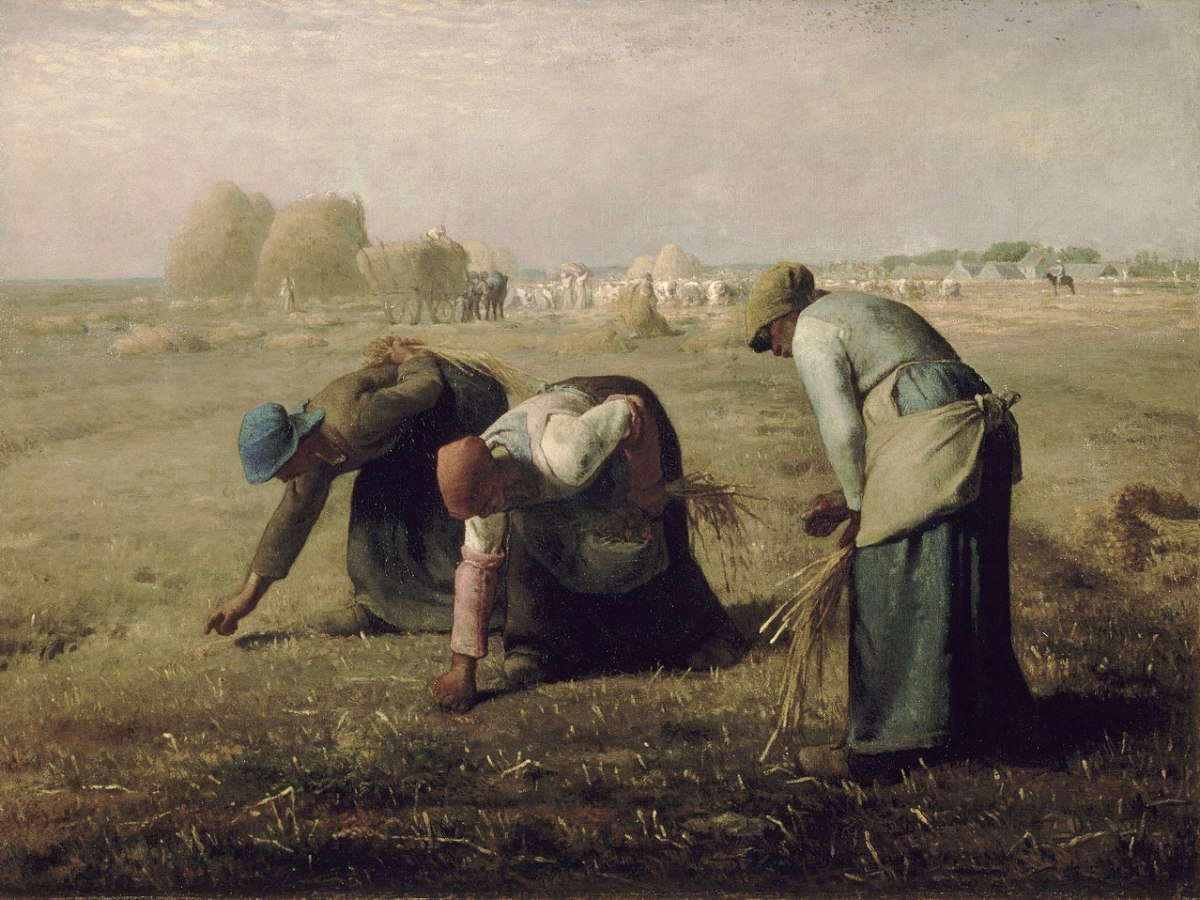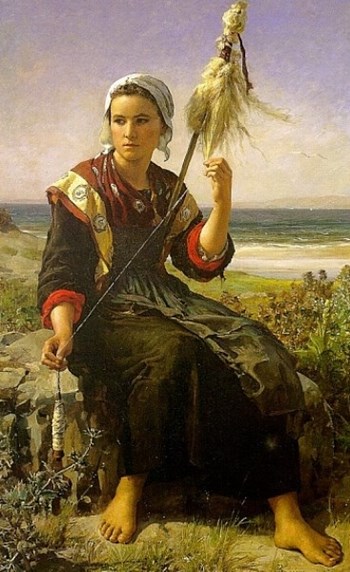
Besides his rural works of art, Jules Breton will also be remembered for his religious paintings. One simple work was his 1869 painting entitled Breton Peasant Woman Holding a Taper, which can be seen at the Brooklyn Museum. It is an intimate portrayal of an elderly lady in Breton costume. Jules Breton made the background plain and dark so that her white headdress and the starched folds of her collar stand out. In one hand she holds the long thin candle whilst the other hand clasps her rosary beads. France may have been reeling from revolutions and turmoil with even worse to come but Breton was happy to focus on regional dress and religious tradition. Since 1994, the painting has been housed at the Musée des Beaux-Arts in Quimper

One of his greatest religious works was his multi-figured depiction entitled The Pardon at the Chapel of Kergoat in Quéméneven. A pardon occurs on the feast of the patron saint of a church or chapel, at which an indulgence is granted. Hence use of the word “pardon”. Pardons only occur in the traditionally Breton language speaking Western part of Brittany. This “pardon” at the Chapel of Kergoat was one of the most popular pardons because of the virtues of the waters from the nearby fountain. The Chapelle Notre-Dame de Kergoat is a 16th century chapel in the hamlet Kergoat, in the commune Quéménéven, Finistère, in north-western France. People came from all over Cornouaille, as shown by the presence of people from the Bigouden area. Jules Breton was moved by the number of beggars and the passion of the pilgrims. His portrayal of the event lets us imagine the movement of this procession as it goes around the monumental chapel.

He, like many other artists such as Gaugin, Pascal Dagnan-Bouveret and the Pont-Aven School painter, Paul Sérusier, depicted similar scenes of devotion.

Another religious procession featured in one of Jules Breton’s paintings. It was his 1857 work The Blessing of the Wheats in Artois which he presented at the Salon that year and was awarded a second-class medal. It was also the year that Jean-François Millet had his famous painting, The Gleaners, exhibited at the Salon. Jules Breton’s painting was bought that year by the French State for the Luxembourg Museum. The procession we see in the painting is a procession of the Rogations. Rogation Days are days set aside to observe a change in the seasons. Rogation Days are tied to the spring planting. There is one Major Rogation, which falls on April 25, and three Minor Rogations, which are celebrated on the Monday, Tuesday, and Wednesday immediately before Ascension Thursday. Around Jules Breton’s village of Courrières, the girls in their communion dresses, the clergy, and the local notables walk the countryside to attract the blessing of heaven to the coming crops. This painting reminds us of the important place of Christianity in French rural life.

Jules Breton was the self-proclaimed “peasant who paints peasants.” During his career, he would paint many pictures that focused on the religious traditions of rural communities, especially those in the towns and villages of Brittany and his birthplace and current home, Courrières. One of the earliest paintings to study the theme of communicants, people who receive or are entitled to receive Communion, was his 1860 work, Les Premières Communiantes à Courrières which hangs in the Musée du Petit Palais, Paris. This work depicts the ceremony of First Holy Communion being held in the village of Courrières, a ceremony during which a person, around the age of eight, first receives the Eucharist. The young girls who are about to receive the sacrament usually wear beautiful white dresses.

In 1884, twenty-four years after Breton completed Les Premières Communiantes à Courrières, he was given a commission by one of his patrons, Samuel Putnam Avery, to complete another work depicting the First Communion ceremony and offered him 50,000 francs for its completion. He gave the artist freedom to choose a depiction of the ceremony. Avery was a great supporter and fan of Breton’s work and in a letter from May 4th, 1882, after Breton had accepted the commission, he thanked him saying:
“…I have so much confidence in your genius I am convinced that you will create a masterpiece, and want to leave you free to do what interests you most…”
Breton set to work in the summer of 1883 making numerous sketches for the finished commission. Avery became impatient as over a year had passed since the commission had been agreed upon and in November Breton wrote once more to Avery saying that the work was nearing completion and that he intended to submit it to the 1884 Salon. Breton has depicted a much broader view of the Communion ceremony. The setting is a Spring morning and the mauve lilac is in full bloom. The “ruralness” of the depiction is enhanced by the inclusion of birds fluttering over the thatched roofs of the whitewashed cottages. The bright sunlight shines down upon the procession and lights up the virginal white diaphanous veils of the young girls as they slowly walk through the village towards the church of Courrières. The painting was hailed a great success and the art critic for the Art Journal who wrote about the 1884 Salon said:
“…Les communiantes is perhaps the finest work in the exhibition… In the detail, the characterization, the perfect technique, the harmonious and varied coloration, and above all in the feeling, this picture is especially fine…”
The work was the culmination of numerous sketches that Breton had taken.

After the Salon closed, Avery purchased the painting for 50,000 francs, and then promptly sold it to the American art collector, Mary Jane Sexton Morgan, the widow of Charles Morgan, an American railroad and shipping magnate. She paid $12,000 for the painting. Charles de Kay, a writer on art wrote in the Magazine of Art:
“…What the most fabulous art dealer, what the most self-important artist asked, she paid without wincing…”
Mary died in 1885 and the following year at the auction of her collection in May 1886, the work was purchased by Donald Smith, Lord Strathcona, president of the Bank of Montreal, for $45,000, the highest price ever paid for a work by a living artist at the time.

Jules Breton’s decision to submit his work to the Salon jurists was not really a gamble as the Salon had shown a love for this type of depiction. Bastien-Lepage’s La Communiante was favourably received by the Salon jurists in 1875. In that work, the young girl at her First Holy Communion ceremony sits in front of us. Her hands are joined on her lap in a touch of reverence. She fixes us with a steady gaze. Her eyes and hair are the only dark details of the canvas. The only colour is that on the face, wrists and arms which are covered under light gauze. The rest of the work is bathed in tones of white and grey.

Two years later, in 1877, the French artist Henri Gervex, had his painting, La première Communion à l’eglise de la Trinité, accepted into the 1877 Salon.

The interesting fact about Gervex and the Salon was his works later turned to more lascivious depictions of nude or semi-nude women and the submission of his painting, Rolla, to the Salon jurists of the 1878 Salon was rejected, on the grounds that it was too risqué and they wanted to avoid the furore which occurred with Manet’s 1865 Salon painting, Olympia, which was accepted into the exhibition but subsequently was condemned by many conservative critics as being “immoral” and “vulgar .

Besides being a talented artist, Jules Breton was a poet and in 1880, had his poem Jeanne published. His poetry was so good that it was awarded the Montyon Prize by the Académie Française. However, he had little time to dedicate to his poetry as the demand for his artwork was escalating and he was now attracting considerable interest from the ever-expanding and lucrative market in America.

Samuel Putnam Avery was a critical part in exposing American audiences to European Art in the second half of the nineteenth century, importing major works by Ernest Meissonier, Charles-François Daubigny and William Bouguereau, among others, and he provided Breton with many sales and commissions on behalf of collectors. The American public liked Breton’s depiction of rural labourers as one art historian, Madeleine Fiddell-Beaufort put it in her 1982 book, Jules Breton and the French Rural Tradition:
“…they [the Americans] appeared to exist in a harmonious and classless society that was appealing in a country that prided itself on a democratic tradition…”

The American market was also aware of Breton’s awards from the various Salons and realised that buying his works was a real investment. Two examples of his work that went to America can be seen in the Joslyn Art Museum in Omaha. The Weeders was completed in 1860. The painting impeccably demonstrates Breton’s Academic approach to painting. The depiction is a delicate blend of realistic observation and a romantic sentiment. Breton has managed to beautifully capture the delicate mauves and roses of the twilight sky and added the simplicity of these stooped figures, Breton has managed to convert the activity of common field labour into a less harsh scene, almost one of graceful contemplation.

Another of his works at the museum is his 1864 work, The Vintage at Chateau Lagrange. The setting of the work is not Brittany where a number of his paintings were set. The painting depicts a festival being held in the Médoc district of southern France just north of Bordeaux. Breton decided to travel to the southern parts of France where he believed lay the “sublime landscapes with inhabitants embodying extraordinary beauty.” It was fortuitous that Breton was invited by Count Charles Tenneguy Duchâtel, the owner of Chateau Legrange winery to visit him and paint a picture depicting the grape harvest at his estate. The setting was ideal for Breton but the adverse weather on his first visit necessitated a second visit to complete his sketches. The painting was then completed in his Paris studio. It is interesting to note Breton’s portrayal of the grape pickers. They seem well-dressed and happy and their work has afforded them a distinctly classical quality and the hard-working process of picking the grapes from the vine has been depicted as a noble task rather than a tiring and arduous chore by poorly dressed and unhappy peasants. Could it be that the Count wanted the painting to depict his workers as well dressed, well fed, happy people who were pleased to serve him?

In his painting, Planatation d’un Calvaire, Jules Breton recounts an event, which he witnessed in his youth. Before us, we see a group of monks carrying on a stretcher the statue of Christ that will be fixed to the wooden cross. In the background of the painting, we can see the cross being erected in the grounds of the churchyard. In front of monks, three young girls wear the symbols of the Passion (the crown of thorns, the nails, and the spear). Finally, behind them, comes the priest, the children’s choir and the parishioners who close the march. The group moves forward in a slow procession towards the great cross, which is in the process of being erected in the background. Breton, through this depiction, reminds himself of the fervor and recollection of this village community. The palette he has used is dominated by grey and beige, and is warmed by colourful tones of yellow, red and blue. Breton’s wife, Élodie de Vigne, is represented twice in this painting. She is both the character of the mother holding her two children by the hand and that of the girl in white carrying a cushion on which rests the crown of thorns.

In 1861 Jules Breton was named Chevalier de la Légion d’Honneur. In 1867 he exhibited ten paintings at the Exposition Universelle and was given a first-place medal. In 1872 he was given the Medal of Honour at the Salon. Jules continued exhibiting at the Salons and was promoted from Officer to Commander of the Légion d’Honneur in 1885, and in 1886 he was elected as a member of the Insitut de France. In 1889-1900 he was also a jury member of the Salon. Towards the end of his career his works often focused on a single figure within the composition.
Jules Breton died in Paris on July 5th 1906, aged 79. His wife Elodie died three years later on July 30th 1909, aged 73.
If you have enjoyed reading about Jules Breton, I can thoroughly recommend you try and read his 1890 autobiography entitled The Life of an Artist which gives you an insight into the great man’s life and his thoughts.







































